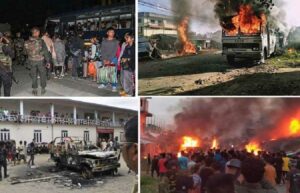Shoot-At-Sight Order Issued In Manipur
Context:
As escalating ethnic violence following a tribal solidarity march forced over 9,000 people from their homes in the State, the Manipur government on Thursday issued a shoot-at-sight order in “extreme cases”.
Points to Ponder:
- Following ethnic violence that broke out during a tribal solidarity march organised by the state’s All Tribal Students’ Union, the Manipur government issued a shoot-at-sight order in “extreme cases.”
- Over 9,000 people have been forced to flee their homes due to the violence, and there have also reportedly been several fatalities and injuries. While acknowledging that “some precious lives were lost,” Chief Minister Nongthombam Biren Singh omitted to give a precise count of the dead.
- The Meitei group, which makes up the majority of the state’s population, was protested against receiving scheduled tribe status. The Meitei community would get several advantages and protections under Indian law if they were designated as a scheduled tribe.
- Hundreds of homes, churches, temples, and vehicles have all been vandalised or set on fire as a result of the violence, which has now expanded over five districts in the state.
- For situational control, the government has sent out more than 500 members of the Rapid Action Force, 55 Army columns, the paramilitary Assam Rifles, and many police officials. The joint forces secured the Imphal-Churachandpur road, which saw a lot of violence.
- After all other means of persuasion, warning, and reasonable force had failed, the order to shoot at sight was given. The rule gives district and executive magistrates the power to decide “extreme cases.”
- Kuldeep Singh, a former director general of the CRPF, has been nominated by the Union Home Ministry as the chief minister’s security advisor. Amit Shah, the minister of the interior, has also presided over two video conferences with the chief ministers of Nagaland, Mizoram, and Assam as well as other senior officials.
- Some districts have curfews in place, and internet access has been cut off. Over 9,000 displaced people have also been saved and housed in safe locations by the government.
- Mobs have persisted in attacking weak points in the impacted areas despite the increased security. The environment is still tight and uncertain.
Background on Ethnic Communities
- Manipur’s population is divided into three primary ethnic groups: Meiteis who live in the valley and 29 large tribes who live in the hills and are divided into the Nagas and Kuki-Chins.
- Zeliangrong, Tangkhul, Mao, Maram, Maring, and Tarao make form the Naga group.
- Gangte, Hmar, Paite, Thadou, Vaiphei, Zou, Aimol, Chiru, Koireng, Kom, Anal, Chothe, Lamgang, Koirao, Thangal, Moyon, and Monsang make comprise the Chin-Kuki group.
- People in the neighbouring Chin state of Myanmar are referred to as “Chin,” whilst on the Indian side, they are known as “Kukis.” Other ethnic groups, such as the Paite, Zou, Gangte, and Vaiphei, refer to themselves as Zomi and have disavowed the name Kuki.
- The fact that all the various ethnic groups belong to the same Mongoloid group and share a great deal of cultural and traditional practices should be recognised.
- Meiteis follow Hindu traditions, which sets them apart from the nearby hill tribes in terms of culture.
- All tribes, including the Meiteis, are said to have emerged from a cave somewhere in the north, according to legend.





